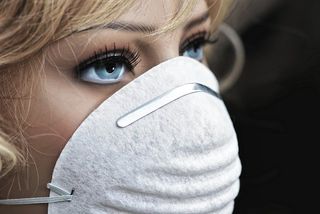Media
Media Exposure to COVID-19: How Much Is Too Much?
Can too much media exposure create stress and harm your health?
Posted April 1, 2020 Reviewed by Ekua Hagan

The novel coronavirus that originated in Wuhan, China in 2019 has spread throughout the world, posing an unprecedented threat to public health. Estimates by Dr. Anthony Fauci, the nation’s top infectious disease expert, suggest that in the coming months, the COVID-19 epidemic is likely to sicken over a million people in the U.S. and cause over 100,000 deaths.
Many states are under stay-at-home orders with all nonessential businesses closed. Many people are working via video while others have been laid off or are unable to do their jobs. With so much time on our hands and activities restricted, the temptation to watch TV or internet coverage of the virus is great. It makes sense to stay informed about the state of the epidemic so we can take reasonable precautions to protect our health, however, watching media coverage for many hours at a time can itself present a threat to your health.
The negative effects of extensive media exposure
The idea that extensive or nonstop media exposure has negative health consequences is based on research done after prior national disasters like 9/11, the Boston Marathon bombing, school shootings, or worldwide health threats like Ebola. A team of researchers from the School of Social Ecology at The University of California, Irvine has researched the effects of media exposure for the past 20 years. These experts suggest that coronavirus media bingeing is likely to have the same psychological and physical health effects as found with these earlier traumatic events.
The researchers state that “repeated media exposure to community crisis can lead to increased anxiety, heightened stress responses that can lead to downstream effects on health, and misplaced health-protective and help-seeking behaviors that can overburden health care facilities and tax available resources.” (Garfin, Silver & Holman, 2020). They cite as an example of misplaced health-protective behaviors the current hoarding of toilet paper and hand sanitizer that lead to worldwide shortages of these items.
In the case of Ebola, worldwide media coverage and exposure to tragic stories led to an overestimate of the risk to U.S. residents posed by Ebola. A nationally representative sample of almost 3,500 U.S. residents showed that heightened media exposure to Ebola-related stories was associated with increased distress, worry, and interference with day to day functioning. In reality, the risk to the U.S. of this disease was relatively low.
The researchers argue that the stress caused by constant media exposure can have longer-term negative effects on health. After the September 11th terrorist attacks (9/11), they found that more hours of TV watching in the days after 9/11 predicted higher posttraumatic stress and the onset of new medical conditions two to three years later (Silver et al., 2013).
A study of reactions to the Boston Marathon bombing found that that media watching was associated with substantial stress. “People who reported the highest media exposure reported higher acute stress than did people who were directly exposed to the bombings” (Holman, Garfin, & Silver, 2014). It could be that those who are more stressed to begin with seek out more media coverage, but this is likely to increase their distress.
Misguided health-protective behavior
Another adverse effect of too much or sensationalized media exposure is that it leads people to engage in misguided attempts to protect their own health that interfere with community health and well-being. In past epidemics, people made more emergency room visits, clogging up the system that was already overloaded by the epidemic. However, the threat of catching the virus in the emergency room may mitigate this effect for COVID-19.
Similarly, when the president touted the benefits of a drug called hydroxychloroquine on TV, people rushed to get their doctors to prescribe it even in the absence of current, serious symptoms. This led to drug shortages for other groups, such as people with lupus, who rely on the drug for their daily functioning. There may be other factors besides too much media exposure that drive panic buying or hoarding behaviors, but media exposure can exacerbate the sense of scarcity or threat.
The role of media and why limited exposure is the answer
The media serve an essential function in a free society in that they expose political truths and hold leaders accountable. They also inform the public about important health threats, the geographical spread of the virus, government action or inaction, and the success of attempts to contain the virus. They recommend appropriate health behaviors such as hand-washing and social distancing and show the positive effects of behavioral strategies on containment. Therefore, some media exposure is healthy and can help us make more informed decisions.
But watching the same type of frightening news or devastating stories over and over again can increase our stress and therefore act as a threat to our future health. Exercising moderation and setting reasonable limits on media consumption can help protect us from this threat. Switch off your TV and read a book, exercise, talk to your family members, do a jigsaw puzzle or crafts, do yoga, bake, or play board games. Your body and mind will thank you.
References
Garfin, D. R., Silver, R. C., & Holman, E. A. (2020). The novel Coronavirus (COVID-2019) outbreak: Amplification of public health consequences by media exposure. Health Psychology. Advance online publication. http://dx.doi.org/10.1037/hea0000875
Garfin, D. R., Holman, E. A., & Silver, R. C. (2015). Cumulative exposure to prior collective trauma and acute stress responses to the Boston marathon bombings. Psychological Science, 26, 675–683. http://dx.doi .org/10.1177/0956797614561043
Garfin, D. R., Thompson, R., & Holman, E. A. (2018). Mental and physical health effects of acute stress following traumatic events: A systematic review. Journal of Psychosomatic Research, 112, 107–113. http://dx.doi.org/10.1016/j.jpsychores.2018.05.017
Holman, E. A., Garfin, D. R., Lubens, P., & Silver, R. C. (2020). Media exposure to collective trauma, mental health, and functioning: Does it matter what you see? Clinical Psychological Science, 8, 111–124. http://dx.doi.org/10.1177/2167702619858300
Holman, E. A., Garfin, D. R., & Silver, R. C. (2014). Media’s role in broadcasting acute stress following the Boston Marathon bombings. Proceedings of the National Academy of Sciences, 111, 93–98. http:// dx.doi.org/10.1073/pnas.1316265110
Holman, E. A., Silver, R. C., Poulin, M., Andersen, J., Gil-Rivas, V., & McIntosh, D. N. (2008). Terrorism, acute stress, and cardiovascular health: A 3-year national study following the September 11th attacks. Archives of General Psychiatry, 65, 73–80. http://dx.doi.org/10.1001/ archgenpsychiatry.2007.6




